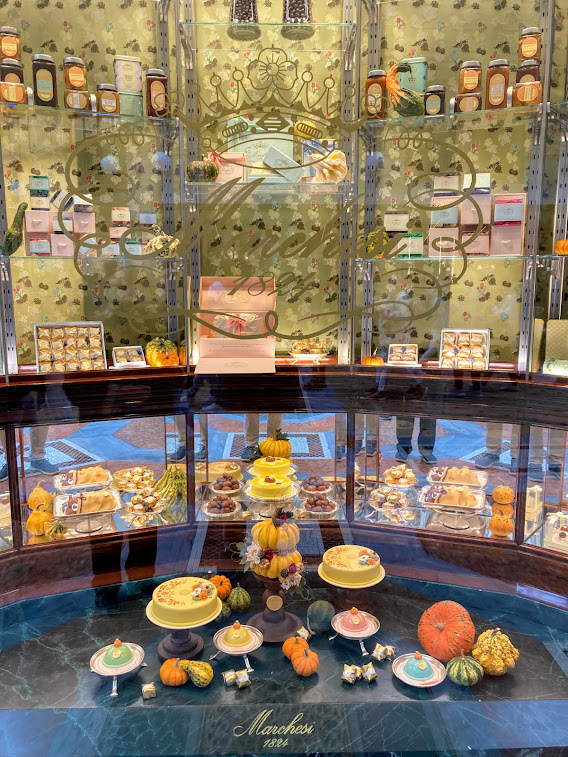not started yet
THE BREAKFAST BUFFET!
THE LOBBY AND THE HOTEL
LA GALLERIA VITTORE EMANUELE II
The Galleria Vittorio Emanuele II is Italy's oldest active shopping gallery and a major landmark of Milan in Italy. Housed within a four-story double arcade in the centre of town, the Galleria is named after Victor Emmanuel II, the first king of the Kingdom of Italy. It was designed in 1861 and built by architect Giuseppe Mengoni between 1865 and 1877.
The structure consists of two glass-vaulted arcades intersecting in an octagon covering the street connecting Piazza del Duomo to Piazza della Scala. The street is covered by an arching glass and cast iron roof, a popular design for 19th-century arcades, such as the Burlington Arcade in London, which was the prototype for larger glazed shopping arcades, beginning with the Saint-Hubert Gallery in Brussels (opened in 1847), the Passazh in St Petersburg (opened in 1848), the Galleria Umberto I in Naples (opened in 1890), and the Budapest Galleria. The Galleria is often nicknamed il salotto di Milano (Milan's drawing room), due to its numerous shops and importance as a common Milanese meeting and dining place
The central octagonal space is topped with a glass dome. The Milanese Galleria was larger in scale than its predecessors and was an important step in the evolution of the modern glazed and enclosed shopping mall, of which it was the direct progenitor. It has inspired the use of the term galleria for many other shopping arcades and malls.
THE DUOMO
Milan Cathedral, or Metropolitan Cathedral-Basilica of the Nativity of Saint Mary (Italian: Basilica cattedrale metropolitana di Santa Maria Nascente), is the cathedral church of Milan, Lombardy, Italy. Dedicated to the Nativity of St Mary (Santa Maria Nascente), it is the seat of the Archbishop of Milan.
The cathedral took nearly six centuries to complete: construction began in 1386, and the final details were completed in 1965. It is the largest church in the Italian Republic—the larger St. Peter's Basilica is in the State of Vatican City, a sovereign state—and possibly the second largest in Europe and the third largest in the world (its size and position remain a matter of debate).
Work for the construction of Milan cathedral began when the style of Gothic cathedrals had reached its peak. It was decided that the new church should be built in the area of the ancient basilicas of Santa Maria Maggiore and Santa Tecla, the remains of which, together with those of the Baptistery of San Giovanni alle Fonti, are still visible in the Archaeological Area.
The long succession of architects and engineers at the head of this innovative and original construction site makes it impossible to trace a certain authorship of the project.
Construction began from the apse, with its awe-inspiring and imposing stained-glass windows, and continued towards the transept and the first spans of the naves, leaving the age-old problem of closing the vault unresolved. At the end of the fifteenth century the greatest architects and artists of the time, including Leonardo da Vinci, tried to accomplish the difficult task of designing the tiburium. Once this phase was concluded and a unanimous decision was reached, construction work continued and a new phase started under the inspiration of the work of Carlo Borromeo.
The design of the church’s façade began at the end of the sixteenth century, when the foundations for its prospetto (front) were laid, meanwhile the ancient façade of the church of Santa Maria Maggiore (which was demolished in 1683) had been rebuilt forward of its original position. As was the case for many other architectural elements of the cathedral, the façade too had to wait for long (until the end of the eighteenth century) before a definitive plan was completed.
Truly a multi-century collaborative and evolutionary project. The end result, however, maintains a strong sense of unity and singular perspective.......it is enormously powerful!
TIME FOR A BREAK!
This is the line waiting just to get tickets to the Duomo........in order to go across the piazza and wait another 30 minutes to get in! We opted out of this one, as we had been inside previously.....back when these simple visits were much less complicated. We decided it was time for a cappucino break and found a fun outdoor cafe on the edge of the Piazza della Scala.
BACK TO THE HOTEL AND A NICE WALK TO LUNCH
 |
| The panini are more important than the people.......and that is a wonderful fennel and orange salad.....phenomenal! |
TIME FOR LA CENA
We decided to hang around the hotel for the evening. The bar is a wonderfully comfortable space, and we found out their menu for dining had changed recently and they were serving an upgraded risotto and Alba white truffle menu! We need no further justification. The risotto milanese with saffron was amazing, and the tagliolini with white truffles was incredible.




























